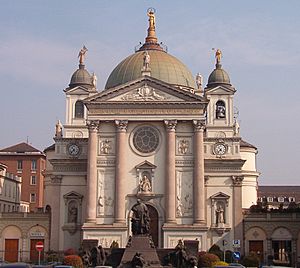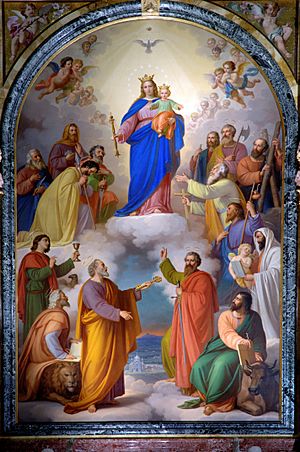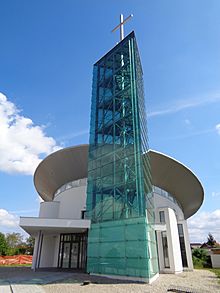Mary Help of Christians facts for kids
Mary, Help of Christians (in Latin: Sancta Maria Auxilium Christianorum) is a special name for the Blessed Virgin Mary in the Catholic Church. This title is linked to a special day of prayer, called a feast day, celebrated every year on May 24.
This title for Mary was first used by John Chrysostom way back in the year 345 AD. Later, Don Bosco also helped make this devotion popular. The title is also connected to times when Christian Europe, including areas in Africa and the Middle East, needed protection from non-Christian groups during the Middle Ages.
For example, in 1571, the Islamic Ottoman Empire tried to invade Christian Europe. Pope Pius V asked Christian armies to pray to Mary for help. When they won the battle, people believed Mary had helped them.
In 1903, Pope Leo XIII officially approved the crowning of a special image of Mary, Help of Christians, in Turin, Italy. This crowning happened on May 17, 1903, and the image is now in the Basilica of Mary Help of Christians.
Contents
The Story of Mary, Help of Christians
Early Mentions of Mary as Helper
Long ago, in the first centuries of Christianity, people used two Greek words for Mary. One was Theotokos, meaning "Mother of God." The other was Boetheia, meaning "the Helper." Early Christian leaders, called Church Fathers, used the name "Helper" for Mary.
For instance, John Chrysostom used this title in a sermon in 345 AD. Others like Proclus in 476 and Sebas of Caesarea in 532 also used it. After the 5th century, many other important figures, like John of Damascus, also called Mary "the Helper."
Some experts believe that calling Mary "Help of Christians" is part of a very old prayer. This prayer, called Sub tuum praesidium, was found on an ancient paper from the 3rd century. The word Praesidium means "strong help given during wartime."
Mary's Title in Prayers
Around 1576, a priest named Bernardino Cirillo published some special prayers to Mary. These prayers are called litanies. One of these litanies, which is still used today, included the prayer "Help of Christians."
It is thought that Christian soldiers returning from the Battle of Lepanto in 1571 first used this title. They visited a holy place in Loreto, Italy, and greeted Mary with this new name. It might also be a change from an older prayer that called Mary "Advocate of Christians."
Some historical writings say that Pope Pius V added this prayer to the Litany of Loreto after the Battle of Lepanto. However, the exact form of the litany with this prayer was not well known in Rome at that time.
The Feast Day of Our Lady Help of Christians
The special feast day for Our Lady, Help of Christians was started by Pope Pius VII. In 1808, a powerful leader named Napoleon had Pope Pius VII arrested. The Pope was held prisoner for a long time.
In January 1814, after a big battle, the Pope was finally set free. He returned to Rome on May 24, 1814. People cheered for him because he had stood strong against Napoleon. The Pope believed that Mary had helped him and the Church during this difficult time.
To remember his struggles and the Church's victory, Pope Pius VII declared May 24 as the feast day of Our Lady, Help of Christians. This feast day quickly became popular in many Catholic areas.

This special day has been celebrated by a religious group called the Servites since the 1600s. The devotion to Mary under this title became very popular in Rome. John Bosco and Vincent Pallotti especially promoted it.
Don Bosco was a strong supporter of "Mary, Help of Christians." He built a large church in her honor in 1868. He also started a group of religious women called "The Daughters of Mary, Help of Christians." Don Bosco saw Mary as the Mother of the Church and a helper for all Christians.
The Second Vatican Council, an important meeting of Catholic leaders, also spoke about Mary as "Help of Christians." They said Mary helps people find a good spiritual life. She cares for all people as a loving mother, guiding them through life's challenges to heaven.
How the Feast Day is Celebrated
On this feast day, the Church focuses on two main ways Mary helps. First, she helps individual believers fight against sin in their lives. Second, she helps Christian communities work together against things that go against Christian beliefs.
Some people might think this idea of fighting "anti-Christian forces" is old-fashioned. However, it is still important for Christians to understand that not all ideas or trends in the world are good or harmless.
The areas around Tuscany, Italy, started celebrating this feast day on February 12, 1816. The songs for the church service were written by Brandimarte.
This feast became very important in places like Australia and New Zealand. After the changes from the Second Vatican Council, it was decided that the feast would be celebrated on the first Sunday on or after May 24.
The Salesian religious group, founded by John Bosco, has done a lot to spread this devotion. Don Bosco dedicated his main church in Turin to Our Lady, Help of Christians in 1868. The Salesians have taken this devotion to many countries around the world.
There are many churches and shrines dedicated to Mary, Help of Christians. For example, there is a Salesian National Shrine in New York, USA, and another in Parañaque City, Philippines. The Belmont Abbey in North Carolina, USA, is also dedicated to Mary, Help of Christians.
There is even a chapel dedicated to Our Lady Help of Christians in the Basilica of the National Shrine of the Immaculate Conception in Washington, D.C.
Chinese Catholics also honor Mary under this title, especially at the Sheshan Basilica in mainland China. In 2007, Pope Benedict XVI asked Chinese Catholics to celebrate her feast day on May 24. This was a way to support them as they face challenges from the government.
Even though it is mostly linked to the Catholic Church, the Eastern Orthodox Church has also known this devotion since 1030 in Ukraine. At that time, Mary was believed to have helped protect the country from invaders.
Popes and Mary, Help of Christians
Many Popes have officially recognized and promoted the title of Mary, Help of Christians.
- Pope Pius V asked people to pray to Mary with this title in 1571 during the Battle of Lepanto. He added this title to the Litany of Loreto. He first created a feast day called "Our Lady of Victory," which was later changed to the "Feast of the Holy Rosary."
- Pope Pius VII honored Mary under this title after he was released from prison by Napoleon Bonaparte on May 24, 1814. He officially started the feast day of Mary, Help of Christians. He also credited Mary for his freedom.
- Pope Pius IX officially declared Mary, Help of Christians, as the patroness (special protector) of Australia in 1852.
- Pope Leo XIII officially approved the crowning of the famous image in Turin on February 13, 1903. This image is now in the Basilica of Our Lady Help of Christians in Turin, Italy.
- Pope Pius X approved the crowning of a special painting of Mary in Brezje, Slovenia, in 1907.
- Pope Benedict XV confirmed Mary, Help of Christians, as the patroness of Australia again in 1916.
- Pope Pius XII officially made the Mary Help of Christians shrine in China a special church called a "Minor Basilica" in 1942.
- Pope John Paul II approved the crowning of an image in Twardogóra, Poland, in 1994. He also made the shrine in Brezje, Slovenia, a Minor Basilica in 1988.
- Pope Benedict XVI spoke about Mary, Help of Christians, in 2009. He asked Chinese Catholics to be loyal to the Pope.
- Pope Francis approved the crowning of two images in the Philippines. One was in San Fabian, Pangasinan, in 2018. The other was in Parañaque City in 2021.
Artistic Representations
-
Mariahilf, painted by Lucas Cranach the Elder around 1520. It is in the Cathedral of St. Jakob in Innsbruck.
See also
 In Spanish: María Auxilio de los Cristianos para niños
In Spanish: María Auxilio de los Cristianos para niños







